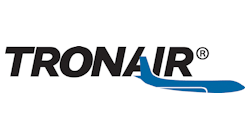Halls filled with attendees and exhibitors milling around booths on the blue carpet of GSE Expo and the red of AS3 attributed to the success of Aviation Industry Week, which also held the Flight Chiefs Meeting and Joint Panel. Add PAMA and NATA Technical Sessions and Industry Overviews and it was one heck of a show.
Paul MacCready's address the night before the show focused on the environmental side of flight. Renewable fuel has become a big issue recently.
"I don't know about what we're going to use as the price of fossil fuel keeps going up," MacCready says. "In five years there will be some serious problems. And no solutions as yet."
MacCready mentioned the military's unmanned airplanes; small planes that can fly for hours controlled remotely — either for deliveries or reconnaissance. Also, the graceful Helios, which broke an altitude record fueled by solar power and wind.
Keynote speaker for the show John Goglia, current NTSB member, focused his remarks on how aviation looks and how it needs to change. According to Goglia, this industry has felt the pain since 9/11 but things are looking up. The passenger load is back, however the airlines still can't make money. The business model has changed therefore everyone will have to change as well. For instance, the airlines won't go back to paying for ground handling services. They will want to keep the "rock bottom" prices they are at.
As Goglia states, "We need to look at what we do, why we do it that way and is there a better way; and we need to do it collectively."
The Future of the Business of Air Transport Ground Support session on Tuesday morning started with a discussion of low-cost air carriers. William Lange of Independence Air talked about his company's move from a partner of United and Delta, to an "independent" entity restructuring into what has come-to-be-known as the low-cost airline model.
Vaughn Cordle, chartered financial analyst, used revenue and expense formulas to show a trend for airlines, namely that legacy airlines cannot compete with the low cost carriers.
Morten S. Beyer, chairman and CEO of MBA (Morten, Beyer & Agnew Inc.) asked if our airport security really makes us secure? He mentioned how the "hassle factor" of security will decrease traffic and that current airports will reach full capacity very soon.
On Wednesday morning, The Future of the Airport: How to Manage Passengers and Ground Support session focused on security.
Bruce DeWitte, product manager at Northrop Grumman Corp. focused on infrastructure protection, or the need for more eyes watching the airports. The company produces a software solution called AlertVideo™, which takes any camera, even an existing security network, and analyzes what the camera "sees." When something occurs that AlertVideo™ was programmed to sense, an alert goes to a human guard who can decide to take action.
Security will be at the hands of airport employees according to Ira Tabankin with TriCentic Technologies' up and coming product called the C.A.T.C.H.E.R (planned for production this August). This small, two pound, computer unit with an LCD screen and enough features to make anyone need the instruction manual, is built to mil spec 10F.
Benny Asklof, ATS Denver Inc., discussed WebCore, a system designed to have a learning curve of five minutes and integrate all other security systems you may have.
Finally, Peter Muller, associate at Olsson Associates, discussed the benefits of personal rapid transit. The Ultra System Transportation Pod (T-Pod) could greatly improve passenger service, security and lower costs.
The environmental impact of aircraft was again addressed in Thursday's The Future of the Environment, Energy and Fuels session, but this time the angle of attack had ground support equipment in the cross hairs.
Bob Arnott disseminated the EPA's Final Nonattainment Designations for 8-Hour Ozone, highlighting areas of the country with ground ozone problems. Many of these are areas with major airline/cargo and/or military operations.
Lynne Pickard with the FAA explained the goals of the FAA to reduce noise and emissions for GSE.
The alternative fuels were covered by William (Bill) Mitchell, manager of the E Diesel Project for the Illinois Corn Growers Association, ex-John Deere, who highlighted the use of ethanol (made from corn or any high sugar/starch material), which has a high short-term renewability unlike fossil fuels.
Kevin Brown, assistant technology manager for Engine Control Systems not only mentioned the environmental hazards of emissions, but brought concern up a notch when he discussed the effects on employees exposed to these emissions over long periods of time. Brown strategized alternative fuels, a turn-over in fleets to newer equipment or at least newer, less polluting engines, and retrofitting existing equipment.
For a more detailed overview of the Aviation Industry Week trade show see the June/July issue of Ground Support Magazine.
Quotes:
"We thought it was an awesome show with good traffic. We really enjoyed the large participation from the military due to the Flight Chiefs and Joint Panel meeting being held during the same week. We were pleased that we experimented by bringing a provisioning truck rather than a de-icer. We were able to show it to our customer first-hand because Southwest Airlines managers came in from so many different locations and they were able to see their new model truck there. It was really beneficial."
— Bill Dempsey, president and COO for Global Ground Support, LLC — An AirT Company
"We (Kurt Rose, CEO and Manager and Jim Lazarus, Manager of Technical Sales and Support) unanimously found the first day to be absolutely excellent. The people that were there were exactly what we were hoping for. We had a significant number of military personnel come by the booth which was very encouraging since we are doing a lot more with the military over the last two years than we have before. They were particularly interested in the new model of our axle jacks and the axel jack trolley that we had on display. We were extremely happy with the show."
— Sean Dwyer, key account manager for Hydro USA Co. — Precision in Aircraft Support
"We had 465 exhibiting companies in 104, 000 net square feet of space (a 15 percent increase from last year in the overall show). Last year the attendance finished at 5,200 (including exhibitors); this year we finished year at 5,800 (almost a 10 percent increase). At least 25,000 square feet of space has been booked for next year already. That just speaks volumes to how successful the show was . . . the fact that people would book space even before they saw that final outcome of this show.
The Flight Chiefs meeting was superb; we were so delighted to have them. Working with Senior Master Sergeant Dynzer and his whole crew of leaders from all of the different commands really was a pleasure. I think they got a lot out of being together at the same time in the same place. I certainly know our exhibitors were thrilled to see them at the show as well. It also gave the Flight Chiefs an opportunity to get out on the floor and see some new technology. It was just a win-win to have them visit us at the show.
The Joint Panel has been including us as one of their quarterly meetings ever since GSE has been around. This is the second year that the group has met under the leadership of Marianne Deuster and again, I think their meeting was incredibly beneficial and it gave them a chance to get in front of the vendors and the vendors a chance to get in front of them . . . and that's always a good thing."
— Jill Hiligenberg, show director
"The show was exciting. There were a lot of people there and we had a tremendous amount of interest from the air force on our B4-B5 Maintenance Platform."
— Paul Spinazze, engineering manager for Tronair — Aircraft Ground Support Equipment







